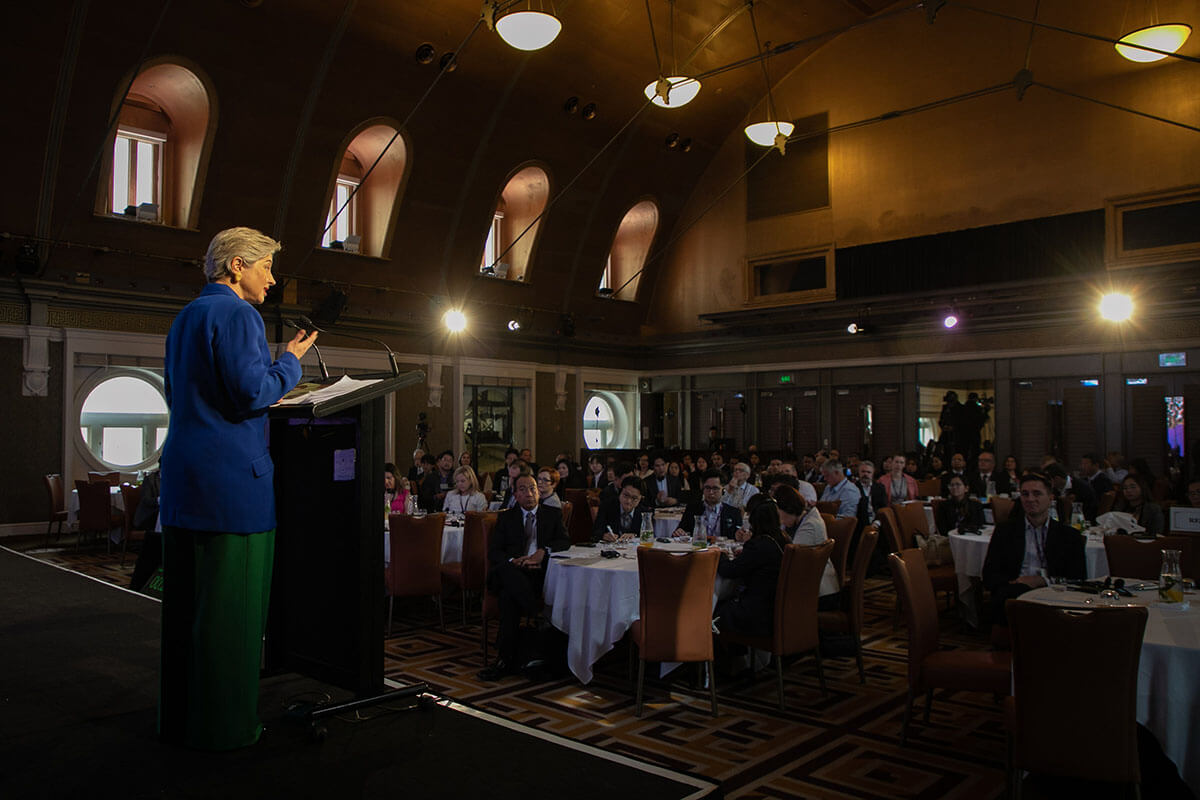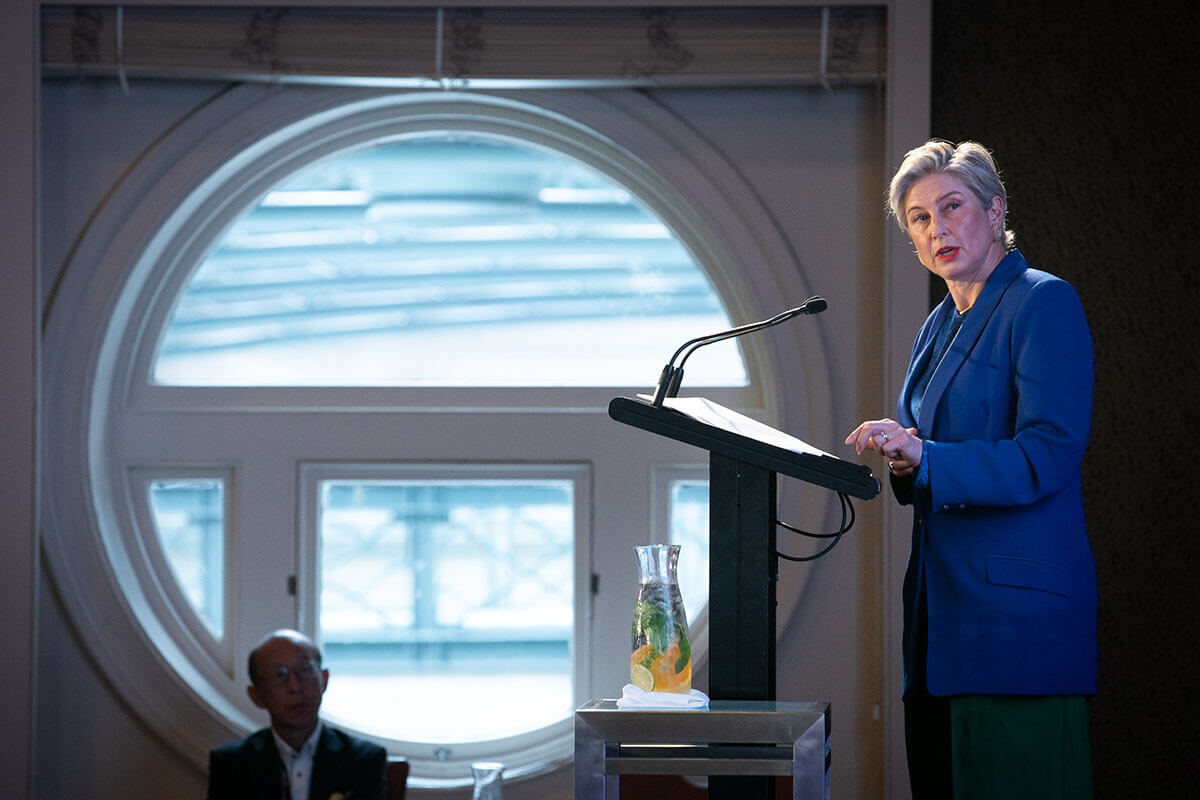28 September 2023
BCCM CEO Melina Morrison delivered the keynote address at ICMIF’s AOA Seminar, a conference of global mutual insurers, hosted by BCCM member Capricorn Mutual earlier this week. Melina spoke about the history, current state, and future vision of mutual insurance in Australia. Read her keynote address.
Mutuals are enjoying a renaissance in the insurance sector globally. In Japan, mutuals and co-ops have a 39.2 per cent share of the insurance market; in Canada, it’s 17.1 per cent. Some of the global issues addressed over the two-day conference included AI and machine learning’s impact on innovation in insurance, climate risk, and the war for talent in the industry post-pandemic.
May I start by welcoming all delegates here today to Australia, to Sydney, New South Wales, and acknowledge in our customary way, the original custodian and owners of these lands, the Gadigal People of the Eora Nation.
I also wish to welcome international guests to the land of mutuals. Look up as you walk the streets of Sydney and you will see the history of Australia’s mutual past – the names of legacy mutual provident societies, friendly societies and building societies are carved in the sandstone facades of many historical buildings.
I wish to extend my thanks to AOA and ICMIF for the invitation to provide today’s keynote on the history and future vision of the mutual insurance sector in Australia.
May I welcome and thank, Mr Yanai and Mr Wesseling, Chairs of AOA and ICMIF respectively. Welcome and thanks to my colleague and friend, Shaun Tarbuck, CEO ICMIF – we look forward to working closely with Liz Green, Shaun, but we will miss your energy and commitment especially for the great moral and existential challenge of climate change.
I’m delighted that you get to experience the hospitality of Rod Scanlon, CEO Capricorn Mutual. It should be no secret that if not for the support and contribution of Capricorn, the BCCM would not exist.
Capricorn Group (and my welcome to Capricorn Group CEO David Fraser) is the founding member of the BCCM and their support has not wavered in our short, but eventful decade since forming.
I also note that friend of the BCCM, Rade Musulin, is speaking today. In case you have not heard, and if Rade is too modest to say – Rade has been recognised for his work in developing solutions for climate change and sustainability by the Actuaries Institute as recipient of their most prestigious annual award, 2023 Actuary of the Year Award together with his Finity colleague Sharanjit Paddam.
I will be speaking later about the huge challenges for Australia when it comes to climate and catastrophe with the flow-on impact to insurance. But to look at the future, we must first understand the past and the current time.
I will speak about risk today – the risk of neglecting our business model and failing to protect or champion it. On the flip side, I will talk about the opportunity when we come together to enable, promote and invest in the model.
This is the history and the future vision of mutual insurance in Australia. The clearest example of this is in life insurance.
Compared to our visibility, co-operatives and mutuals are a large sector in Australia. This graphic shows the scale and the size of all Australian co-ops and mutuals in all sectors.
In total we are almost 2000 enterprises, with more than 33 million memberships, more than individual Australians, because many people are members of more than one co-op or mutual.
Eight in 10 Australians are members of at least one co-op or mutual. But only 3 in 10 know they are a member.
The total assets of the sector are almost 1.5 trillion, in large because we have a huge mutual pension industry. Co-operative retirement funds, or member-owned superannuation funds, transfer the risk of retiring to the mutual, investing wisely to secure good retirement income for ordinary Australians. They are also affinity partners with mutual insurers potentially now able to invest through mutual capital instruments or partner to benefit large numbers of members – potentially shared members.
In Australia 43 mutuals primarily of exclusively provide insurance and risk protection services.
They have an annual turnover of $12.7 billion and hold combined assets of $22.2 billion under management.
Numerous other mutuals provide insurance or risk protection in conjunction to their primary activities: motoring, healthcare, financial services.
Major insurance and risk protection mutuals in Australia include:
- Health: HCF, Australian Unity, HBF, HIF and Westfund Health (with more than 4 million members combined)
- Motoring and general: RACQ, RAC, RAA and RACT (with more than 8 million members combined)
- Employment and workers compensation: EML, and Employsure
- Professional Indemnity: MDA National, MIGA, MIPS, and Lawcover
- Sector specific: Capricorn Mutual, Catholic Church Insurance, UniMutual, StateCover, and CivicRisk.
- Agriculture: Aussie Farmers Mutual and StockInsure.
It is remarkable that the same firms that were market leaders at the turn of the century were still the largest and most successful firms a century later.
In 1982 the five largest mutual life offices in terms of the value of assets and premium income were: the AMP, National Mutual Life, the Mutual Life and Citizens, Colonial Mutual Life, and the T&G Mutual Life.
Mutual insurers are some of the most trusted brands in Australia, which is why some of them still carry the brand name after demutualisation.
The decision to demutualise was often driven by an organisation’s need to access external capital to expand the business. However, the experience of demutualisation is that most businesses become the target of takeovers or mergers and cease to trade as independent entities.
“The Australian insurance industry is a good example of this and has suffered a major loss of diversity through demutualisation, with many former mutuals now a part of larger merged (and listed) insurance groups.”


Let’s go back to the golden era for mutuals. The history of Australian insurance mutuals is a story tracking major events and demographic shifts over 200 years.
The Australian gold rushes in the 1850s provided the catalyst for the establishment and expansion of the life insurance industry. The significance of the gold rushes for the industry was: (1) they generated a rapid growth in the population of the country, and (2) they provided the capital base upon which the country began to industrialise and urbanise.
The first mutual life insurance association was the Australian Mutual Provident (AMP), founded in 1849. The AMP was initially registered as a friendly society in a bid to overcome the problem of member liability. The AMP remained the only Australian mutual society for twenty years.
As the leading supplier of life insurance in Australia, AMP helped to reinforce a consumer preference for the mutual form of association. The mutual philosophy suited the emerging colonial ethos of mateship. It was a rationale solution to the vagaries and uncertainties of settler life.
The life insurance industry underwent a period of expansion. During the period 1870-1885, 10 new Australian life insurance firms were established. All these new entrants were firms based on mutual principles of providing for policyholders rather than shareholders.
The failure of proprietary insurance companies to provide life insurance on any type of scale reflected the problem of writing long term contracts under uncertainty. Mutual associations
faced these same constraints but proved capable of overcoming them because of the underlying philosophy on which they were established.
“If we want to see life insurance business transacted with genuine earnestness – we only glance at the Australian colonies. Mutual companies are there in the ascendant and it is no exaggeration to say they are worked with an energy to which on this side of the globe are entirely strange.” – The Commercial World, 15 August 1882
In 1880: mutual firms accounted for 81 per cent per cent of new policies sold. In 1890: this had risen to 90 per cent.
In the 1890s the expansion of life insurance investment was curtailed with the onset of one of the severest depressions the country had experienced.
The first of the banks failed in January 1893 and within five months a further 12 of the 22 trading banks had collapsed.
Compared to other financial institutions, life insurance associations weathered the collapse relatively well as they were not deposit taking institutions and were not threatened by a run on their resources. However, they suffered a decline of new business and a lapse of policies, and a default on mortgages and lost income from interest.
However, unlike banks and building societies (another strong form of mutualism in Australia) no life association folded because of the financial upheaval and smaller societies which found it difficult to keep going in the deteriorating economy amalgamated with larger organisations rather than liquidate.
The tendency to amalgamation rather than liquidation has been a characteristic of the Australian industry. The underlying mutual philosophy of the associations in the market, placed a much greater emphasis on the co-operative ideal, particularly in the nineteenth century.
1920s: The industrialisation of the economy and the corresponding increase in urbanisation created was unprecedented.
With the development of motor transport, electric power, and the telephone there was an increased demand for public expenditure. Previously Australian governments had looked overseas for a source of funds, in the aftermath of the First World War this was not practical.
In the 1920s, local savings as a source of finance were utilised by government for the first time, and the investment of mutual life insurance companies came to play an important part in the provision of public sector finance.
With the outbreak of Second World War, the banking sector came under the control of government. The post-war period saw an extension of the restrictions imposed on the banking sector by government controls.
For 35 years, the Australian banking sector was one of the most highly regulated in the western world. The regulation perpetuated market segmentation by limiting the ability of the industry to expand into other areas of finance, preserving the status quo in the life insurance industry.
In 1979 the Australian government commissioned the first of several inquiries into the operation of the financial sector. The process of deregulation of the financial sector, inspired by the recommendations of this first report (the Campbell inquiry) was an on-going feature of the sector for most of the 1980s and 1990s.
In a 15-year period, Australia moved from having one of the most regulated financial sectors to one of the least regulated. Today we have one of the most profitable and concentrated listed banking sectors in the world.
As deregulation spread in the 1980s, banks and other financial institutions moved into the domain of the life insurance industry, and the large life offices sought to enter the banking sector.
This was accompanied by a reassessment of the value of the mutual structure. This process has been part of an ongoing global trend to demutualisation which has occurred since the 1980s. Demutualisation of insurance offices, building societies and other thrift institutions have occurred in Britain, Canada, South Africa and the USA.
Demutualisation gutted the sector. In 1985, five mutuals owned nearly 60 per cent of the industry’s assets; by 1998 this had fallen to under 1 per cent.
Since 2013 and the birth of the BCCM, we have been dealing with the catastrophic impact of demutalisation on the mutual sector in Australia. Starting with a Federal Government inquiry into the barriers to competition and innovation for co-operatives and mutuals, the BCCM has led an advocacy campaign to reform the regulatory regime and amend legislation to enable mutuals including insurance mutuals to compete on a level playing field with listed companies.
Notably, that has included new laws enabling mutuals to raise equity capital without demutualising. This is the first enabling legislation for mutuals in 18 years. It has led to a positive definition and test for mutual companies in law. The first mutual to raise capital using these new laws was legacy health insurance mutual – Australian Unity.
This has come about at a pivotal time for mutual insurance as markets harden and communities and businesses are looking for innovative solutions.
A key recommendation of the BCCM’s policy blueprint is to promote corporate diversity.
The history of Australian business shows that co-operatives and mutuals have been the true ‘challenger’ institutions to the largest corporate businesses. By delivering their purpose to provide affordable goods and services to consumers in insurance and banking and commodities markets, co-operatives and mutuals provide real price competition.
Regulators should be responsible for ensuring that a wide range of corporate providers are available to consumers. The BCCM advocates for a statutory obligation on regulators to measure and promote corporate diversity in financial services and other industry sectors.
Have you been to our beautiful city beaches? Or have you visited our famous harbourside zoo? It is no secret that Australia is home to some extreme climates and dangerous animals. We have sharks where we swim, deadly spiders and snakes where we build our homes and gardens. Every beach has a voluntary surf lifesaving club and many country towns have a volunteer fire brigade.
Beyond our dangerous critters, as an island continent, Australia is vulnerable and exposed to: (1) Climate change, (2) Supply chain disruptions and food insecurity, (3) pandemics, and (4) Inequality.
According to the IPCC, Australia will suffer longer, hotter summers, more bushfires and coastal erosion worse than the rest of the world.
Australia is a land of contrasts and catastrophy – An El Nino season has been declared once more. The increasing frequency and scale of atural disasters is placing unprecedented pressure on insurance and insurers and markets are hardening.
According to some reports our crop yields will decline, our tourism industry will be impacted and the cost both societal and economic will be unprecedented.
Australia is especially vulnerable to supply chain security as an island nation. The COVID-19 pandemic showed just how vulnerable we are whether it’s medicines, food, workforce, or staple consumables.
Australia experienced a period of isolation and detachment during the recent health crisis with travel in and out of the country severely restricted.
Supply chains failed for essential products like medicines and masks, hand sanitiser, fertiliser and chemicals.
The pendulum is swinging back to mutual solutions and we’re seeing rapid growth in mutuals as a response to societal need including in housing, care, and disaster resilience especially in thin markets where the market is failing.
Future growth needs to be underpinned by the best operating environment for co-operatives and mutuals, including:
- Better legislation, including access to capital
- Better regulation, including regulations that understand corporate diversity
- Better industry practices, such as the BCCM “Principles, Code of Conduct and Good Practices for Discretionary Mutual Funds”
To ensure that mutual insurance can thrive to its optimum, the BCCM advocates to government leaders for greater awareness of mutual solutions, including in the arena of insurance and risk protection.
The Australian Small Business and Family Enterprise Ombudsman’s seminal report “The Show Must Go On,” said operating a discretionary mutual fund is not easy as it requires exception governance practices.
“While not everybody will agree with each of the items, it may be wise for the sector of the Business Council of Co-operatives and Mutuals to consider the development of a documented ‘best practice guide’.” – Bruce Billson, Ombudsman.
At a time of burgeoning interest in Discretionary Mutual Funds it’s critical that sector play a stewardship role to ensure suboptimal practices don’t enter the market.
People trust Discretionary Mutual Funds because we are the calm centre in a world of swirling risk and uncertainty.
The pendulum is swinging back to this tried and trusted model of risk protection, especially in markets that have hardened. We are seeing huge growth in Discretionary Mutual Funds across many lines of cover, but it comes with risks. This is why we have taken the Ombudsman recommendation seriously and worked with our members to develop a voluntary industry code of best practice to ensure that DMFs are established on the true mutual principles.
The history of mutuals in this country is also the history of our modern nation. Mutuals built this country, and they are the bedrock of community resilience. Because of these mutual insurers, friendly societies included, fledgling communities in Australia flourished. Private equity raided these firms and made off with the loot, and we’ve been on the back foot since. The energy of this movement, the reforms we’ve made, and now access to capital have given us a new zest. Our next legislative test is to introduce legacy asset protection for mutual insurers in Australia.
Beyond access to capital, mutual insurers must invest in best practice and innovate. We must be in the market able to compete on price and quality, quality of product and services, and assurance on sustainability.
We must walk the talk. The BCCM has invested in ESG education and awareness for mutuals, developing an accredited course in sustainability for co-ops and mutuals, a climate action policy for co-ops and mutuals.
We have also developed a measurement framework for mutuals to measure, benchmark and communicate their total value creation across six dimensions of value. Mutual Value Measurement is also a framework for accrediting mutuals.
The way forward is co-operation.
We are members of ICMIF and the ICA to ensure we are connected to and supporting the international movement through solidarity and exchange.
We have been guided and led by our colleagues around the world, such as the excellent program you will enjoy over the next two days. We have been learning from the global movement about sustainability and climate initiatives, customer experience, member engagement and digital transformation.
I hope you have a wonderful conference.
Thank you and again, stay in touch.




